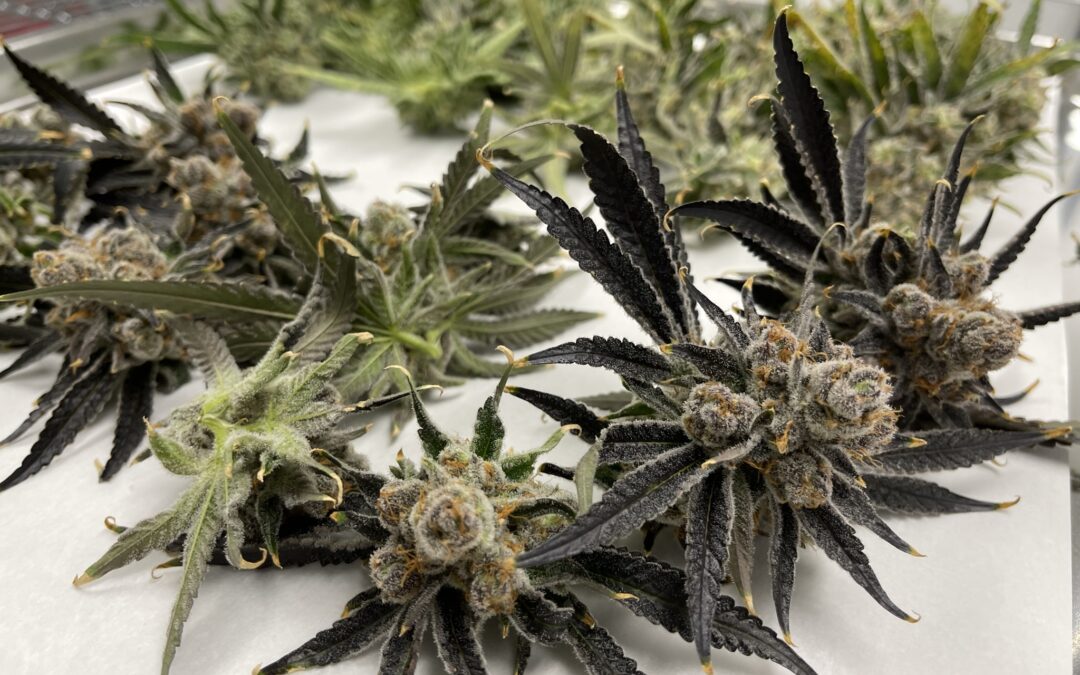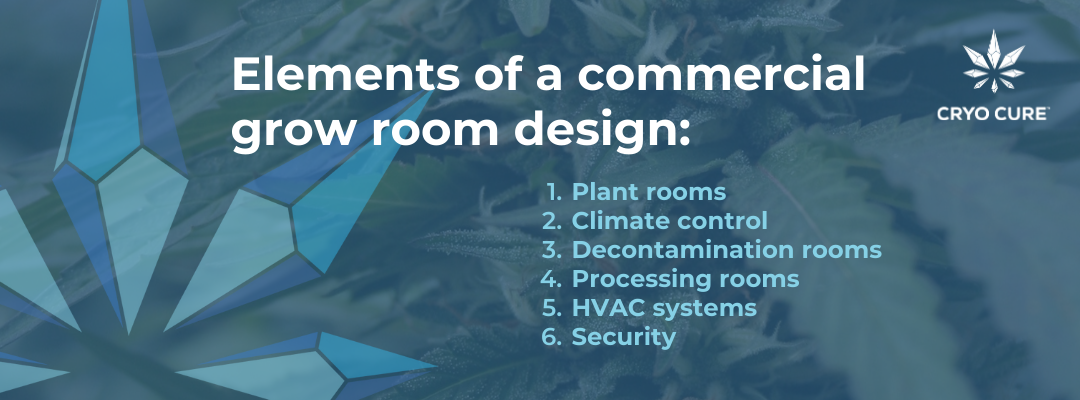Building out a grow facility takes planning, planning, and more planning. From top to bottom, every inch is calculated carefully to meet your operation’s goals, meet local regulations, and properly accommodate for finicky, sensitive plants at every growth stage.
If you’re considering Cryo Cure as part of your initial grow room design or in an expansion of your current facility, you’re in luck: Our machines take up a fraction of the space when compared to a traditional dry room. But before you figure out where you plan to keep Cryo Cure, look into what goes into a commercial grow operation so you can best understand your next steps and how our drying and curing process fits in.
Elements of a commercial grow design
Cannabis cultivation has been shaped quite differently than other crops due to the decades-long illegal status that forced operations indoors and out of sight. Commercial grow room design is shaped by this history, informing the basics of every setup.
Though your needs as a business owner will vary based on the technologies you employ, the size of your facility, state regulations, and other factors, the following design elements of a commercial grow facility are commonplace and can be found in any setup.
- Plant rooms. Your facility will need space to accommodate for the unique needs of your plants at each stage. Separate vegetation and flowering rooms are common, and further division and environment control is needed from cultivar to cultivar. Though there’s some debate as to how much vegetation room you really need, these rooms are the lifeblood of your grow operation. Don’t forget space to hang your cannabis for drying and set aside for curing!
- Climate control. Cannabis isn’t a “set and forget” kind of crop. These plants need specific amounts of light, nutrients, humidity, and water to thrive. To provide that, your grow operation needs specialized equipment like:
- Lighting rigs (either LED lighting or HPS lighting, depending on your preferences)
- A preferred irrigation system
- Nutrient management systems
- Air purification systems, and
- Carbon dioxide injection and monitoring systems
All those systems need to be carefully monitored and controlled, which is often done with a dedicated environmental computer control system and cultivation software to ensure the plants’ needs are met around the clock.
- Decontamination rooms. Given how fickle cannabis can be, anything that enters the sterile grow environment can cause mold, mildew, pesticides, or other disease that can spell certain doom for your entire crop. Staff members who do not follow careful protocol can risk introducing these threats into a grow environment. To combat that, you’re going to need specialized rooms to let your employees change into more sterile clothes or put on protective gear. This is an absolute must when drawing up an integrated pest management plan.
- Processing rooms. On-site processing rooms allow your employees to properly trim and package the final product. For some cultivators with a processing office, those rooms will house the specialized machinery necessary for terpene extraction or phytocannabinoid extraction.
- HVAC systems. More than just keeping everything cool, a commercial grow operation relies on its HVAC system to provide proper airflow and help control humidity. This includes systems for air filtration and purification, both for odor and for airborne contaminants; these systems may be part of the HVAC system or come as separate units. These systems are also necessary to create positive air pressure in the grow rooms, since doing so will help mitigate potential contamination from potential bugs and pathogens.
- Security. While it may not be directly related to cultivation, your commercial grow room facility needs proper security to safeguard the plants and all the equipment inside. Surveillance, alarms, security lights, and recording systems are just a few of the security protocols you may need to install on site, both for your own peace of mind and to meet any requirements set out by the state.
Space considerations for a commercial grow room design
In many states where cannabis has been legalized for medical or adult use, legislators typically place licenses into categories broken down by size, often linked to the square footage of the facility. As plants require a certain amount of space to properly propagate, the size of your new grow op will depend largely on the conditions of your license
Typically, most commercial grow operations are housed in a warehouse-style building. These constructions are large, steel structures, with the average production area coming in at around 36,000 square feet in 2020. Keep in mind that it doesn’t mean it contains 36,000 square feet of plants – all the space, equipment, and other requirements for the grow facility are contained within that single building.
According to engineering consulting firm Mintropy, a craft grower that’s licensed by the Department of Agriculture to cultivate, dry, cure, and package hemp or marijuana “must contain at least 5,000 square feet of canopy space for the cannabis plants during the flowering stage of their life cycle.” Depending on the individual market need, the agency can increase or decrease that amount by increments of 3,000 square feet, with a maximum of 14,000 square feet for cultivation.
How much room does a drying and curing area typically take up?
The drying and curing process involved in cannabis cultivation is one of the most important steps in the entire process. Dry rooms need to provide ample space for proper airflow as the buds dry. This means that there needs to be adequate space between each branch as it hangs or lays flat to dry. There also needs to be ample room for HVAC systems, fans, and other climate control methods.
As far as how big your drying and curing rooms should be, Excel Air Systems suggests that a drying room should be a “non-exterior walled room with high insulation value in both the walls and ceiling.” Each of these rooms should be “at least 10 feet wide by 10-20 feet long are capable of housing up to several hundred dry pounds.” Any more and they suggest building multiple dry rooms, rather than making one massive room, to better control the climate and airflow in that space.
How Cryo Cure saves space in your commercial grow facility
While you could dedicate entire rooms to drying and curing your cannabis, Cryo Cure technology occupies just a fraction of the space. While we are best known for our patent-pending technology that preserves phytocannabinoid and terpene-rich trichomes, our technology accomplishes this without taking up tremendous amounts of space.
Cryo Cure’s CC350 model can single-handedly dry and cure between 30 and 60 pounds of cannabis or hemp in a matter of 24 to 36 hours. All that magic happens within a space that’s less than nine feet long, under 5 feet wide, and just slightly under 7 feet tall! To boot, the CC350[SM6] is outfitted with wheels, so the machine can move throughout your facility as needed. For larger operations, the CC720 boasts 625 square feet of internal shelf space in a space that’s 15 feet long, 6 feet wide, and less than 9 feet tall.
Space is a precious commodity in your commercial grow room operation, and every square foot should have a calculated purpose. At Cryo Cure, our technology is engineered to save as much space as possible while providing an unforgettable value add for your customers and consumers who love the Cryo Cure smell, taste, and experience.




